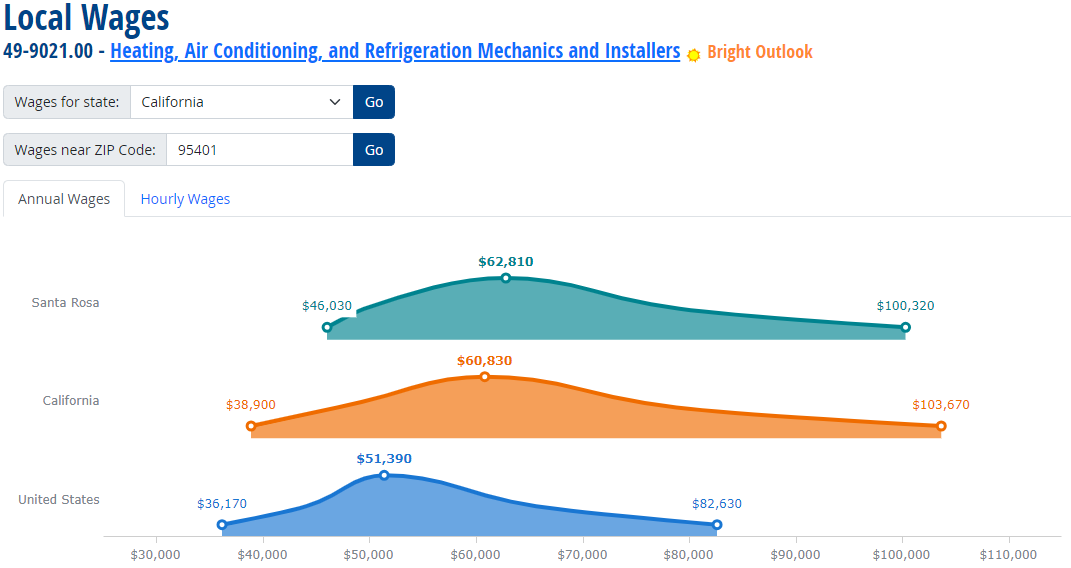HVACR Labor Market Information
Occupational Information Network (O*NET)
Heating, Air Conditioning, and Refrigeration Mechanics and Installers
Standard Occupational Classification: 49-9021.00
Job Description: Install or repair heating, central air conditioning, HVAC, or refrigeration systems, including oil burners, hot-air furnaces, and heating stoves.
Sample of reported job titles:
- A/C Tech (Air Conditioning Technician)
- HVAC Installer (Heating, Ventilation, and Air Conditioning Installer)
- HVAC Mechanic (Heating, Ventilation, and Air Conditioning Mechanic)
- HVAC Service Tech (Heating, Ventilation, and Air Conditioning Service Technician)
- HVAC Specialist (Heating, Ventilation, and Air Conditioning Specialist)
- HVAC Tech (Heating, Ventilation, and Air Conditioning Technician)
- Refrigeration Mechanic
- Refrigeration Operator
- Refrigeration Technician (Refrigeration Tech)
- Service Technician (Service Tech)
Skills
- Operations Monitoring — Watching gauges, dials, or other indicators to make sure a machine is working properly.
- Critical Thinking — Using logic and reasoning to identify the strengths and weaknesses of alternative solutions, conclusions, or approaches to problems.
- Troubleshooting — Determining causes of operating errors and deciding what to do about it.
- Installation — Installing equipment, machines, wiring, or programs to meet specifications.
- Reading Comprehension — Understanding written sentences and paragraphs in work-related documents.
Knowledge
- Mechanical — Knowledge of machines and tools, including their designs, uses, repair, and maintenance.
- Building and Construction — Knowledge of materials, methods, and the tools involved in the construction or repair of houses, buildings, or other structures such as highways and roads.
- Customer and Personal Service — Knowledge of principles and processes for providing customer and personal services. This includes customer needs assessment, meeting quality standards for services, and evaluation of customer satisfaction.
- Engineering and Technology — Knowledge of the practical application of engineering science and technology. This includes applying principles, techniques, procedures, and equipment to the design and production of various goods and services.
- Computers and Electronics — Knowledge of circuit boards, processors, chips, electronic equipment, and computer hardware and software, including applications and programming.
Abilities
- Near Vision — The ability to see details at close range (within a few feet of the observer).
- Problem Sensitivity — The ability to tell when something is wrong or is likely to go wrong. It does not involve solving the problem, only recognizing that there is a problem.
- Deductive Reasoning — The ability to apply general rules to specific problems to produce answers that make sense.
- Arm-Hand Steadiness — The ability to keep your hand and arm steady while moving your arm or while holding your arm and hand in one position.
- Finger Dexterity — The ability to make precisely coordinated movements of the fingers of one or both hands to grasp, manipulate, or assemble very small objects.
Work Styles
- Dependability — Job requires being reliable, responsible, and dependable, and fulfilling obligations.
- Attention to Detail — Job requires being careful about detail and thorough in completing work tasks.
- Innovation — Job requires creativity and alternative thinking to develop new ideas for and answers to work-related problems.
- Integrity — Job requires being honest and ethical.
- Independence — Job requires developing one's own ways of doing things, guiding oneself with little or no supervision, and depending on oneself to get things done.

